
(continued)
The next three years of my life I spent selling insurance and flying charters on the side for a local FBO on an on call basis. One Saturday about noon I got a call to fly a charter to a small uncontrolled airport about 50 miles south east of Wichita. The dispatcher told me I would be flying a Cessna 182 and carrying a man and a dog...a 150 pound dog! I instructed the dispatcher to find out more about the dog because, "If a 150 pound dog decides at any time that he wants to get out of the airplane he will." The dog turned out to be a solid black Great Dane and every bit of 150 pounds, and very well under control. The dogs handler came along and explained that the dog was trained as body guard and responded only if an opponent raised his or her hands above their waist. The dog responded only one time;when we returned to Wichita the line boy raised his arms to direct us to where he wanted us to park.
After about the three year point in my "survival job" as an "insurance man" I had become a District Manager and was preparing to move to Topeka, Kansas. Donna and I had even put some money down on a house there. One day Donna took a call in Wichita from a company with whom I hade made application for a flying job just over two years earlier but to this day had received no response. The chief pilot wanted to know if I was still interested. Donna and I talked it over and decided that I was.
This was my first corporate flying job. I "Paid my dues", as they say, flying a C-55 Baron. No autopilot, no de-ice boots, no radar, no RNAV, and a directional gyro with the card orientated horizontally. In 1977 this airplane was replaced with a 58TC Baron. Better performance and all the the equipment to do just about whatever you wanted to do.
After about three years of the Baron, which I enjoyed very much, I moved up to the company's E-90 King Air. The most high-tech thing in this airplane was a PN-101. Hell, I thought I had died and gone to heaven! After about five years with company, the Chief Pilot lost his medical and I became the Chief Pilot by default. It wasn't long after this that the 84 year old founder and Chairman of the Board retired with a new wife. The idiot son took over and immediately sold the King Air so that he could show a profit at the end of his first year. He then built a new corporate office building with a million and a half dollars that he thought he had in the coffers but didn't. Oh, brother! This was my que to move on to other things, which I did after seven years with the company.
I took a job as the Chief Pilot with a well established Wichita business that had recently been purchased by a huge California based company with a flight department about the size of United Airlines. The California conglomerate had already purchased a brand new 690B Commander, which I was hired to fly and manage. This airplane was equipped with so much flight and navigation equipment that the factory in Oklahoma City refused to install it because they didn't think it could be cooled properly, and didn't want to stand behind it. Not to be deterred the Chief Pilot in California contracted with a small company in Columbus, Ohio to do the installation. For the most part Columbus did a very good job but they had to completely gut the airplane, and it took three months after the airplane was delivered from the factory to get it up and going. In the meantime my new boss is going nuts because he has to go everywhere on the airlines. The whole thing was not getting off to a very good start.

|
The 690B was a great pilots airplane but I don't know how the passengers endured it. Human factors experts the engineers at Commander were not. The airplane had an air cycle machine for cooling and like most air cycle units of the day it worked the best when you didn't need it. It, for all practical purposes, didn't work at all on the ground. The cabin had huge picture windows on each side:The only thing was that the "picture" the passengers got was that of gear doors flying open unexpectedly and the gear falling out of the wing. Shortly thereafter they got to experience the airplane apparently slamming into the ground at what must have appeared to be 450 miles per hour since they were sitting only two feet off the surface of the runway. If the runway happen to be wet and/or slushy the spray and other debris thrown up by the prop reverse must have only added to their excitement. This airplane, in my opinion, was not a good passengers airplane.
Flight departments fold for many reasons and when they do the people who are running them don't always know why. This one folded in about one year and the only thing I know for sure is that it happened because of things that occurred at the upper levels of the home office, and beyond. I do know that new President was spending from 40 to 100 hours per month in the airplane and the home office in
|
California I suspect was not comfortable with that. He was used to getting around the country in a Lear 35 that belonged to the previous owner, and didn't realize that to maintain the same travel schedule in the Commander took more than twice the time. Anyway, the airplane was shipped off to another division of the parent company and me and my co-pilot became unemployed.
For the better part of the next year I engaged in yet another career. I started my own photography business. I did numerous weddings, personal photography, and did most of the photography for a local university. Business was good but this career was a lot of work, and it wasn't something I wanted to do.
Spring of 1980. An airplane salesman friend asked if I would consult with a client of his who was trying to buy an airplane but couldn,t decide what he wanted. It was to be his first airplane. I said I would if he would recommend me to this gentleman as his pilot when the time came. He agreed and we struck a deal.
The man who wanted to buy the airplane was is in the oil business, which was very good at the time. He was good friends with Russ Meyer the president of Cessna. I found out that Russ had been trying to talk him into buying a new, in stock 414 from my salesman friend. On a Thursday the oilman decided he was going to buy the proposed 414 and put some money down. He then hired me and I was scheduled into school for the airplane on the following Monday. On Saturday, a hot July day, I was to take this gentleman and his family from Wichita to Kansas City and back on their first trip in the 414. Everything went fine until climbing through about 8000 feet when the right engine suddenly turned normally aspirated. I shut the engine down and returned to Wichita where we found out that one of the couplings on the intake manifold had come loose. On Sunday the buyer called me to say that he decided not to buy the 414 and asked me to come into his office in the morning to discuss alternatives.
The alternative, as it turned out, was that the oilman still wanted an airplane. However, he had now decided that he wanted to buy a turbine powered airplane since he spent a lot of time in places like Aspen and Gunnison and Meeker, and he wanted to be able to take his family to these places "...safely." Having had previous experience with King Air's I was able to recommend this airplane to him. He said he didn't want a C-90 because he, "Never bought the bottom of the line anything." So, he settled on a King Air E-90, which had to be pre-owned since they were no longer in production. About a week after this discussion I hit the road looking for an E-90 King Air.
|
I found a beautiful E-90 in Albuquerque which the company subsequently bought. I flew this airplane for almost six years until late 1985. The job was great but it was slow motion since I flew only about 20 hours per month. To keep from going nuts I flew with a good friend of mine as co-pilot in a Lear 35. I also instructed part time for Flight Safety International specializing in the Cessna Conquest I;this was one of the most enjoyable and rewarding things I have ever done in my aviation career.
In the 1984-85 time period the bottom fell out of the oil business when the price per barrel slipped from more than $40 to less than $20 and the oil man sold the E-90 to a friend who ran a company in Salina, Kansas just 90 miles north of Wichita. One of the hardest
|
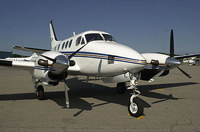
|
things I ever had to do was take that beautiful King Air, that I had put so much time into, up to Salina and turn it over to an airplane driver (not to be confused with a pilot) with no turbine experience, who previously had flown freight in a Beech Model 18.
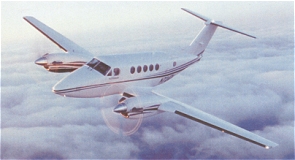
|
In February of 1986, on a Friday, I got a call from a man who ran a company that was building a pipeline from Santa Barbara, California to Houston, Texas. A mutual friend had given him my name. The company owned a King Air B200 and he needed a pilot immediately. The money was right so I signed on and on Monday morning I was on the parent company's Sabreliner on the way to Houston for King Air 200 school at FlightSafety.
This was a great job simply because the people were great, but it was a lot of work and I was gone a lot. It was common for us to take off on monday morning and not get back until Friday evening, week after week. A lot of flying hours. The 200 is a great airplane and it got us around the country very nicely. However, we should have had a jet.
|
One Sunday I got a call from the President, who was probably the nicest guy I ever flew for, and one of the formost pipeline builders in the country. He said that the next morning we would be going to Dayton, Ohio home base of the company who put up the money for the pipeline project. This company had agreed to remain anonymous and give this man a free hand in the building of the pipeline as a condition of employment. He would then get to apply his expertise at building the pipeline, and they would make a lot of money for years to come. In the Sunday papers was a full page ad saying that this company was building this pipeline and how great they were for doing so.
The President was going to Dayton to tell them to refrain from advertising the pipeline or they could get someone else to build it. The reason was simple, if they advertised what they were doing they would be forever mired in lawsuits from one end of the pipeline to the other. In their arrogance they said, "We're providing the money we'll do what ever we want." The president quit, the company moved to Austin, Texas, without me, and the pipeline was never finished. Arrogance kills.
Late Fall 1986. Based on previous experiences I didn't want to go back into "Corporate America", so when I got a call from a friend of mine saying that Beech was hiring demonstration pilots in their new Beechjet program I wasn't all that enthustastic. However, I had done a lot of business with Beech in the past and I knew a lot of people in the sales and service department so I decided to at least look into it.
|
I went to work for Beech in October of 1986 in the Marketing Department as a Product Specialist and Demonstration Pilot. There were four of us in the Beechjet program, three doing all the work and one spending all of the budget he could get his hands on and taking credit for everything. In keeping with the system in place at the time we were expected to be the Beechjet operational experts. If customers called into the factory with questions they were shuttled to one of us.
The Beechjet was the first jet program owned by Beech Aircraft. Sometime earlier they had tried to market the Hawker but this effort didn't meet with much success. The Beechjet was the result of Beech purchasing the Diamond series of airplanes from Mitsubishi Heavy Industries of Japan. They renamed the Diamond II as the Beechjet when they accquired the program in late 1985. Airframe parts were shipped complete (fuselage, wings, tail pieces, etc) from Japan and assembled at the factory in Wichita.
I had expected to be subjected to a strict "code of conduct" in the ways of demonstrating an airplane "the Beech way." I was wrong. There was no "Beech way" in any of the product groups as far as I could ever determine. We did it our way, as we went.
|
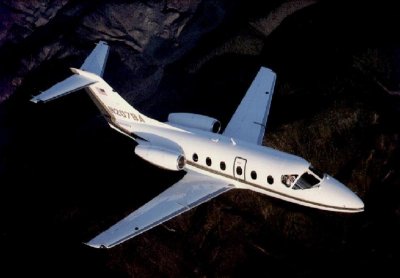
|
Flying the Beechjet all over the world as a Demo Pilot was much more than I could have ever expected. It was a wonderful experience, but I never worked so hard in my life flying airplanes. The people running the program would just keep piling "food" on your plate as long as you would eat it. I went through many periods of six weeks without a day off, usually in some foreign country. Ah, corporate America! What am I doing here?
I liked the Beechjet. It is easy to fly and very forgiving. It's shortcomings are handling qualities and range-payload. The flight characteristics are miserable when compared to other light jets. The airplane is, realistically, a 1300 nautical mile range airplane, with full fuel, no wind, and safe IFR reserves. With full fuel you can take two pilots and up to three passengers.

|
In late 1988 I left the Beechjet program and joined the Starship marketing group. The first production Starship had just been completed. This first airplane was to be delivered the next spring at the Paris Airshow.
The first and subsequent Starship's were great prototypes but the most miserable production examples I had ever seen! The quality was far less than it could have been. The systems, especially the air conditioning, were at best unreliable. The ground and flight handling qualities were the worst I had ever experienced. The performance was far less than expected. The first production airplane was so noisy it was actually painful to fly in it. After my first flight with a test pilot I was presented with a button that said, "I've just flown the Starship, please speak up!" All of these problems, and more, turned out to be the downfall of the entire Starship program simply because Beech (Raytheon) refused to bring the airplane up to production standards once it was certified.
|
After my departure from Raytheon (not to be confused with Beech) in February of 1994 I went to work on my own as a freelance corporate pilot. I flew the Lear 35 for two different local companies and later the Lear 60 for one of them.
Thanks again for your patience. I have written all about my experiences with the infamous Starship on a separate page, if your interested
Click Here.
|
The Lear 35 is one of the most useful airplanes ever built. It is all but impossible to load the Lear 35 over weight and out of CG. If you operate out of the middle of the country as I do, you can easily go anywhere in the US non-stop. The Lear 35 is a nice flying airplane and has spectacular performance, but it is not easy to fly. The aerodynamics are not "state of the art" which dictates some rather absolute limitations that you must constantly be aware of. The airplane is equipped with stick shakers, stick pullers, stick pushers, stick nudgers, and Mach trim, to tame its bad habits. On all models the upper surface of the wing is covered with vortex generator of one form or another. A yaw damper is required for all operations. The systems are primative when compared the standards of the day and require a relatively high degree of management to operate safely. The Lear 35 is not very forgiving and must be operated strictly in accordance with its limitations, and you must stay current or you're asking for trouble.
|
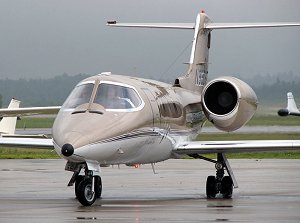
|
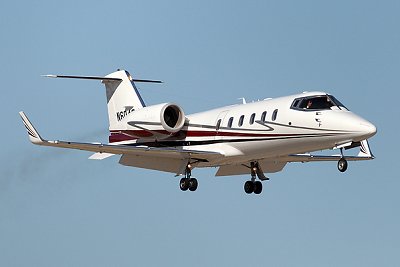
|
The Lear 60 is a larger airplane and an even more spectacular performer than the 35. The 60 has a gross weight of 23,500 pounds, and a power-to-weight ratio of 2.55 to 1 compared to 2.61 to 1 for the 35. The airplane is faster than the 35 (440 KTAS for the 35;460 KTAS for the 60), but with start-of-the-art engines and electronic engine control system (FADEC) the 60 burns about the same amount of fuel, overall, as the 35.
The aerodynamics of the Lear 60 are basically a carryover from earlier models with one notable exception, devices that Learjet calls Delta Fins. It is hard to imagine a aerodynamic fix as simple yet more effective. These devices are installed as far aft on the fuselage as possible, in the same position as a ventral fin normally is. The difference is that there are two of them protruding at an angle so that they provide additional tail area in the horizontal plane as well as the vertical plane. As the angle of a attack increases and the tail of the airplane begins to lose effectiveness the delta fins are there to provide additional directional and longitudinal stability.
|
They are so effective that all of the angle of attack correcting devices (stick puller, stick pusher, etc.) can be removed. Even the yaw damp is not required under any flight condition. The airplane retains the stick shaker for stall warning.
The wing on the Lear 60 is another story. It would be nice if at cruise one could use more of the thrust from the Pratt & Whitney engines to drive the airplane above Mach .80 but the wing just isn't cabable enough. So, the power comes back to just over 90 percent and the airplane cruises right at Mach .80 or a true airspeed of 460 knots (530 mph).
The electrical system in the Lear 60 is all new and is an exceptional design. The pressurization system is new and is completely automatic. The hydraulic system, and the fuel system are basically the same as the 35. Astoundingly, the oxygen system with all of it's potential dangers, and then some, is the same as the Model 35.

|
One of the nice things about being on your own is that you get to take advantage variety of opportunies:
One of my best contracts was to take a gentleman from India and give him 100 hours in his company's brand new 350 before he took it to India. It seems that in India you must have a type rating and at least 100 hours in type before you can fly an airplane commercially. He was a former Indian Air Force MIG-17 pilot. The 350 had everything but a fireplace. We could go anywhere we wanted as long as he ended up with at least 100 hours. ("And just think, I get paid to do this.") Well, logging 100 hours in a 350 King Air took a lot lon ger than I would have guessed. We went to Long Beach, California, Seattle, Miami (twice), the Grand Canyon, South Lake Tahoe and just about anyplace else we could think of and still didn't have close to 100 hours. Just think 13 round trips Wichita to Seattle or Miami would equal approximately 100 hours!
In 1996 I got a contract to instruct flight, and abbreviated ground school to US Air Force pilot's in the C-12J (civilian 1900C Airliner) at Elmendorf AFB, Anchorage, Alaska. These people were expert pilot's and great people to work with, and it was a fantastic experience. Alaska is absolutely spectacular and flying in Alaska made it even more spectacular. If you ever go to Alaska you will never forget it. We all taught each other something. I still keep in touch with some of them by e-mail.
A year or so later I delivered a brand new King Air 350 up through Canada, Alaska, and Russia to China. Operating out of Beijing I trained Chinese Flight Facilities Check Pilots to operate the 350. This experience was enough to write a book about all by itself. Maybe later.
|
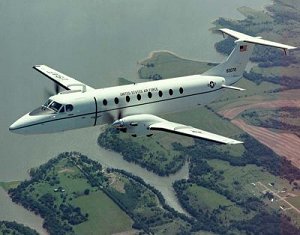
|
In April 2000 I resigned from being a contract pilot and decided that I wanted to go back to teaching. It was time, after all I was 63 years old, too old, probably, to be zipping around the sky in jet airplanes, but too young to retire from life, right. I liked the Lear 60 so much that I decided that it was the airplane I would like to teach. I applied to FlightSafety International at their Tucson Center where I had received my LR-60 type rating. I went to work there as an ground/simulator instructor in late April of 2000 with the idea of moving Donna and two cats to Tucson.
|
We enjoyed Tucson, somewhat to our surprise, but it only lasted until September 11, 2001. Me and another instructor turned out to be, " . . .the last one's in . . ." and thus, " . . .the first one's out . . ." during the subsequent layoff. Reportedly the first in FlightSafety's history. Fortunately for us our house in Wichita had not yet sold and we returned to Wichita in mid October where I applied at FightSafety's Cessna Training Center. Two years later, in May of 2003 I re-joined Flightsafety this time instructing the Citation 650, an airplane in the same class as the Lear 60. This is how I spend some of my time today.
I worked at the FlightSafety Cessna Center in Wichita until October 30, 2014 when a King Air B-200 crashed into the building where I worked. I was about 20 minutes from being there. As a result of this crash the 650 program at FlightSafety in Wichita went away never to return. The only 650 simulator left was in San Antonio, Texas. I spent the next 5 months traveling to and from San Antonio to help out at that center.
|
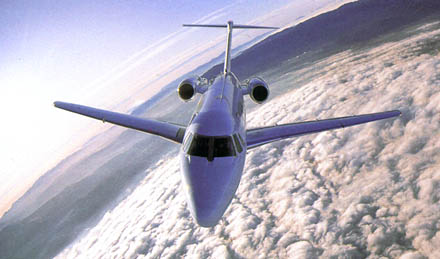
|
I worked at the FlightSafety Cessna Center in Wichita until October 30, 2014 when a King Air B-200 crashed into the building where I worked. I was about 20 minutes from being there. As a result of this crash the 650 program at FlightSafety in Wichita went away never to return. The only 650 simulator left was in San Antonio, Texas. I spent the next 5 months traveling to and from San Antonio to help out at that center.
In March of 2015 I transferred to FlightSafety's East Wichita Center and retrained into the King Air 350 program as an instructor. That's where I work today.
On July 25, 2016 I received the Wright Brothers Master Pilot Award from the FAA for 50 years in aviation flying airplanes; 17,000 hours - 2 years of the 50 years were spent in the air flying 50 different airplane types. Thanks for the memories.
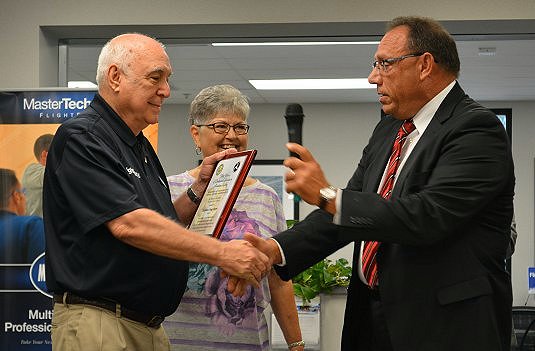
Well, there you have it, my life story as a career pilot in a nutshell. Thank you for reading it. I will add details to this brief story as time goes by.










